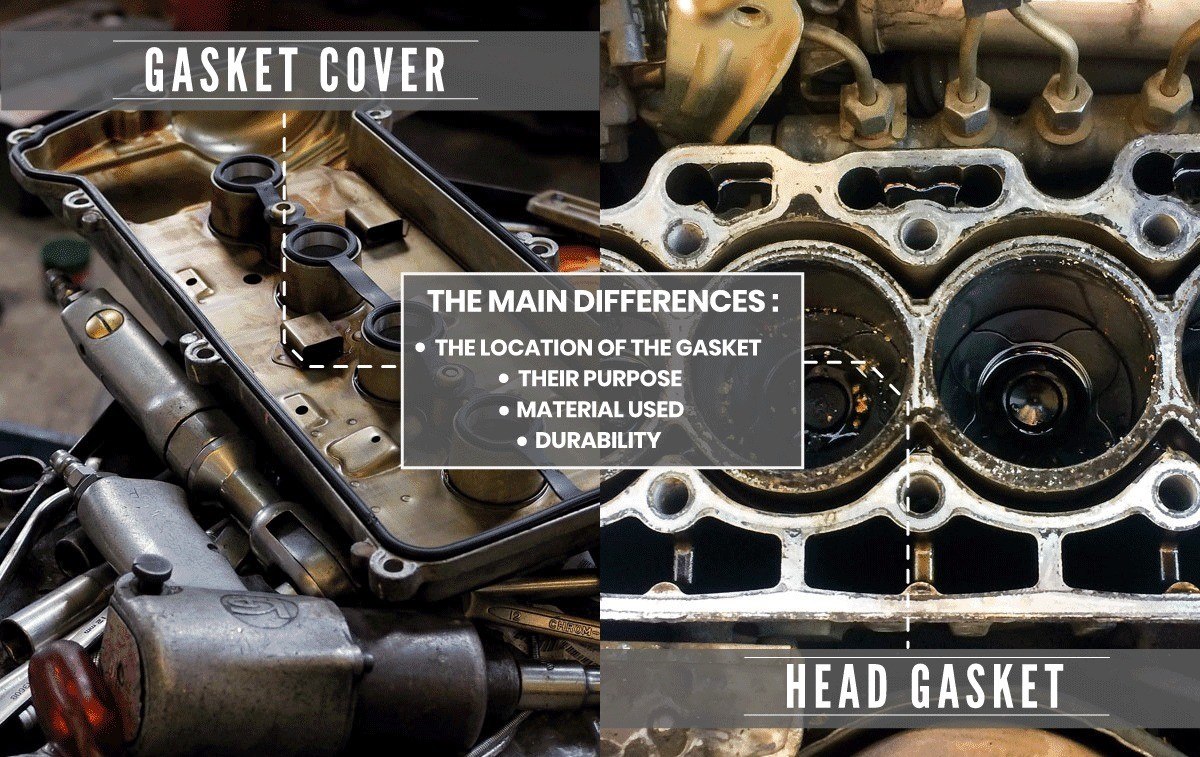Home>Automotive>Head Gasket Vs. Valve Cover Gasket: Unveiling The Hidden Battle Under The Hood


Automotive
Head Gasket Vs. Valve Cover Gasket: Unveiling The Hidden Battle Under The Hood
Published: January 23, 2024
Discover the critical differences between head gaskets and valve cover gaskets in the automotive world. Uncover the hidden battle under the hood and make informed decisions.
(Many of the links in this article redirect to a specific reviewed product. Your purchase of these products through affiliate links helps to generate commission for Noodls.com, at no extra cost. Learn more)
Table of Contents
Introduction
When it comes to the intricate workings of an automobile, there are numerous components that play crucial roles in ensuring the smooth operation of the engine. Among these components, gaskets hold a significant position, acting as the unsung heroes that maintain the integrity of the engine's various systems. In this article, we will delve into the world of gaskets, focusing on two vital types: the head gasket and the valve cover gasket. These seemingly small and inconspicuous parts carry a heavy burden, as they are responsible for sealing critical areas within the engine, safeguarding against leaks and maintaining the proper functioning of the vehicle.
As we unravel the differences and functions of the head gasket and the valve cover gasket, we will gain a deeper understanding of the pivotal roles they play in preserving the engine's performance. Furthermore, we will explore the warning signs of potential failures in these gaskets, shedding light on the importance of timely diagnosis and repair to prevent extensive damage to the engine.
Join us on this journey through the intricate world under the hood of your vehicle, where seemingly minor components wield significant influence. Let's embark on an exploration of the head gasket and valve cover gasket, unveiling the hidden battle that takes place within the heart of the automobile.
Understanding the Function of Gaskets
Gaskets are unassuming yet vital components within an automobile's engine, serving as crucial seals that prevent leaks and maintain the integrity of various systems. These thin, flat materials are typically crafted from multi-layered steel, copper, rubber, or composite materials, and are strategically placed at key junctions throughout the engine to create a secure barrier against the escape of fluids or gases.
The primary function of gaskets is to ensure airtight and watertight seals between components, effectively preventing the leakage of oil, coolant, and combustion gases. By forming tight seals, gaskets contribute to the efficient operation of the engine, preserving the optimal pressure and temperature levels within the different systems.
In addition to sealing critical junctions, gaskets also play a pivotal role in compensating for irregularities in the mating surfaces of engine components. This is particularly important in areas where two components meet, such as the cylinder head and engine block, where the gasket acts as a buffer, filling in tiny imperfections to maintain a secure seal.
Furthermore, gaskets are designed to withstand extreme conditions, including high temperatures and intense pressure, without succumbing to deterioration or failure. This resilience is essential for ensuring the long-term functionality of the engine, as gaskets must endure the rigors of daily operation and temperature fluctuations without compromising their sealing capabilities.
In essence, gaskets serve as the unsung guardians of an automobile's engine, silently upholding the structural integrity of critical systems. Without these unassuming components, the engine would be susceptible to leaks, decreased performance, and potential damage due to the escape of vital fluids and gases.
As we delve further into the distinct roles of the head gasket and valve cover gasket, it becomes evident that these small yet mighty components are indispensable to the smooth and efficient operation of the engine. Let's now turn our attention to the head gasket, a silent hero that plays a pivotal role in the engine's functionality.
Head Gasket: The Silent Hero
Nestled between the engine block and cylinder head, the head gasket stands as a silent sentinel, bearing the weight of immense responsibility. This unassuming yet vital component plays a pivotal role in maintaining the structural integrity of the engine, effectively sealing the combustion chambers, coolant passages, and oil galleries. By creating a tight seal between the cylinder head and engine block, the head gasket ensures that the combustion process occurs within the designated chambers, preventing the escape of exhaust gases and maintaining optimal pressure levels.
The head gasket's significance becomes even more apparent when considering its role in separating the oil and coolant channels from the combustion chambers. This crucial function prevents the intermixing of oil and coolant, safeguarding the engine from potential damage and maintaining the purity of each fluid. Additionally, the head gasket acts as a barrier, preventing coolant from leaking into the combustion chambers and oil passages, and vice versa.
In addition to its sealing properties, the head gasket also plays a critical role in maintaining the compression ratio within the engine. By ensuring a tight seal between the cylinder head and engine block, the head gasket contributes to the efficient compression of the air-fuel mixture within the combustion chambers, essential for the engine's performance and power generation.
Despite its silent demeanor, the head gasket's significance cannot be overstated. This unassuming component stands as a guardian of the engine's integrity, steadfastly upholding the boundaries between vital systems and channels. Its resilience in the face of extreme temperatures and pressures is a testament to its unwavering dedication to preserving the engine's functionality.
As we unravel the intricate workings of the head gasket, its silent heroism becomes increasingly evident. This unassuming component silently ensures the engine's smooth operation, steadfastly maintaining the structural integrity of critical systems. Now, let's shift our focus to the valve cover gasket, another unsung protector that plays a pivotal role in safeguarding the engine against potential leaks and malfunctions.
Valve Cover Gasket: The Unsung Protector
Nestled atop the cylinder head, the valve cover gasket quietly fulfills its role as a steadfast guardian of the engine's well-being. This unassuming yet vital component is tasked with sealing the junction between the valve cover and the cylinder head, effectively safeguarding against oil leaks and maintaining the integrity of the engine's upper components.
The valve cover gasket's primary function revolves around sealing the small gap between the valve cover and the cylinder head, ensuring that the oil within the valve train remains contained and does not escape onto the engine's exterior. By creating a tight seal, the valve cover gasket prevents oil from seeping out and potentially contaminating other engine components, such as the spark plugs or ignition coils.
In addition to its sealing properties, the valve cover gasket also acts as a buffer, compensating for any irregularities or imperfections in the mating surfaces of the valve cover and cylinder head. This crucial function ensures that the seal remains secure, even in the presence of slight surface variations, thereby preventing oil leaks and maintaining the optimal functioning of the engine's upper region.
Furthermore, the valve cover gasket plays a pivotal role in maintaining the proper lubrication of the valve train components. By preventing oil leaks, the gasket ensures that the valves, camshafts, and other vital components within the valve train receive the necessary lubrication to operate smoothly and efficiently. This not only preserves the longevity of these components but also contributes to the overall performance and reliability of the engine.
Much like its counterpart, the head gasket, the valve cover gasket operates silently, diligently fulfilling its duties without seeking recognition. Its resilience in the face of fluctuating temperatures and constant exposure to engine oil is a testament to its unwavering commitment to protecting the engine's vital components.
In essence, the valve cover gasket stands as an unsung protector, quietly maintaining the integrity of the engine's upper region and preventing potential oil leaks. Its role in preserving the proper lubrication and functionality of the valve train is instrumental in ensuring the smooth operation and longevity of the engine.
As we unravel the intricate workings of the valve cover gasket, its silent yet indispensable contribution to the engine's well-being becomes increasingly apparent. Now, let's delve into the warning signs that may indicate potential failures in these critical gaskets.
Signs of Head Gasket Failure
Detecting potential head gasket failure is crucial in preventing extensive damage to the engine. Several warning signs may indicate a compromised head gasket, serving as red flags that warrant immediate attention and diagnosis. It is essential for vehicle owners to remain vigilant and recognize these indicators to address potential issues promptly.
-
Overheating: One of the most prominent signs of head gasket failure is recurrent engine overheating. When the head gasket deteriorates, it can lead to the leakage of coolant into the combustion chambers or oil passages, disrupting the engine's cooling system. As a result, the engine may exhibit persistent overheating, often accompanied by steam emanating from the radiator or a noticeable loss of coolant without any visible leaks.
-
White Exhaust Smoke: A failing head gasket can allow coolant to seep into the combustion chambers, leading to the production of white exhaust smoke. This distinct smoke, often resembling a dense white cloud, indicates the presence of coolant within the exhaust system, signaling a potential breach in the head gasket.
-
Milky Oil: Upon inspecting the engine's oil dipstick or filler cap, the presence of a milky or frothy substance indicates the contamination of oil by coolant. This emulsified mixture, known as "mayonnaise," results from coolant infiltrating the oil passages due to a compromised head gasket, necessitating immediate attention to prevent further damage to the engine.
-
Loss of Compression: A failing head gasket can disrupt the engine's compression, leading to decreased performance and power generation. This may manifest as rough idling, misfiring, or a noticeable reduction in overall engine power, indicating potential compression leaks caused by a compromised head gasket.
-
Coolant Leaks: External coolant leaks near the cylinder head or engine block can signify a compromised head gasket. These leaks may appear as puddles beneath the vehicle or as visible seepage around the engine, signaling the need for a thorough inspection to identify the source of the leak and address any underlying head gasket issues.
-
Combustion Gas Leakage: In some instances, a failing head gasket can allow combustion gases to escape into the cooling system, leading to increased pressure and potential damage to the radiator or hoses. This may result in visible bubbles or agitation in the coolant reservoir, indicating the presence of combustion gases and necessitating immediate attention to prevent further complications.
Recognizing these signs of potential head gasket failure empowers vehicle owners to take proactive measures in addressing underlying issues before they escalate. Timely diagnosis and repair of a compromised head gasket are essential in preserving the engine's functionality and preventing costly repairs. If any of these warning signs are observed, seeking professional assistance to conduct a comprehensive inspection and necessary repairs is imperative to maintain the engine's integrity and performance.
Signs of Valve Cover Gasket Failure
Detecting potential valve cover gasket failure is essential in maintaining the optimal performance and integrity of the engine. The valve cover gasket, although often overlooked, plays a crucial role in preventing oil leaks and preserving the functionality of the engine's upper components. Recognizing the warning signs of potential valve cover gasket failure empowers vehicle owners to address underlying issues promptly, preventing extensive damage and ensuring the smooth operation of the engine.
Several indicators may signify a compromised valve cover gasket, serving as red flags that warrant immediate attention and diagnosis:
-
Visible Oil Leaks: One of the primary signs of a failing valve cover gasket is the presence of visible oil leaks around the perimeter of the valve cover. These leaks may manifest as oil seepage along the edges of the valve cover or as noticeable drips accumulating beneath the engine. The presence of oil residue on the engine block or other components near the valve cover further indicates potential gasket failure.
-
Burning Oil Smell: A distinct burning oil odor emanating from the engine compartment can indicate oil seepage due to a compromised valve cover gasket. This noticeable scent, often described as a pungent or acrid aroma, suggests that oil is escaping onto hot engine components, such as the exhaust manifold, and burning upon contact, signaling the need for gasket inspection and potential replacement.
-
Smoke from the Engine Compartment: When oil seeps from a failing valve cover gasket onto the hot surfaces of the engine, it may result in the production of smoke or vapor emanating from the engine compartment. This visible smoke, often accompanied by a burning odor, serves as a clear indicator of potential gasket failure and necessitates immediate attention to prevent further oil leaks and potential damage to the engine.
-
Contaminated Spark Plugs: Upon inspecting the spark plugs, the presence of oil deposits or fouling may indicate oil leaks resulting from a compromised valve cover gasket. Oil contamination on the spark plugs can disrupt the ignition process, leading to rough idling, misfires, or decreased engine performance, emphasizing the need for gasket inspection and potential replacement.
-
Reduced Oil Level: A declining oil level without a noticeable external leak may signify internal oil seepage due to a failing valve cover gasket. Monitoring the engine's oil level and addressing unexplained decreases can aid in early detection of potential gasket issues, preventing oil starvation and engine damage.
Recognizing these signs of potential valve cover gasket failure empowers vehicle owners to take proactive measures in addressing underlying issues before they escalate. Timely diagnosis and replacement of a compromised valve cover gasket are essential in preserving the engine's functionality and preventing costly repairs. If any of these warning signs are observed, seeking professional assistance to conduct a comprehensive inspection and necessary repairs is imperative to maintain the engine's integrity and performance.
Diagnosis and Repair
Diagnosing and repairing issues related to head gasket and valve cover gasket failures is a critical aspect of maintaining the optimal performance and longevity of an automobile's engine. When confronted with potential gasket failures, it is imperative to conduct thorough diagnostics and execute precise repair procedures to address underlying issues and prevent further damage.
The diagnosis process typically begins with a comprehensive visual inspection of the engine compartment to identify visible signs of gasket failure, such as oil leaks, coolant seepage, or unusual residue around the cylinder head or valve cover. Additionally, specialized diagnostic tools, such as a compression tester or a leak-down tester, may be employed to assess the engine's compression and identify potential leaks caused by a failing head gasket. These diagnostic tests provide valuable insights into the engine's internal condition, aiding in the accurate identification of gasket-related issues.
Upon confirming the presence of head gasket or valve cover gasket failure, the repair process necessitates meticulous attention to detail and precision. The removal of the cylinder head or valve cover, depending on the affected gasket, is a delicate procedure that demands careful disassembly of surrounding components to access the gasket. Once exposed, the compromised gasket is meticulously replaced with a high-quality, OEM-recommended gasket to ensure a reliable seal and long-term functionality.
In addition to gasket replacement, addressing potential underlying causes of gasket failure is essential to prevent recurrent issues. This may involve inspecting the cylinder head or valve cover for irregularities, ensuring proper torque specifications during reassembly, and verifying the integrity of surrounding components, such as the cooling system or the valve train. Thorough attention to these details is crucial in preventing future gasket failures and preserving the engine's integrity.
Furthermore, the repair process may encompass additional maintenance tasks, such as flushing and refilling the cooling system, replacing contaminated engine oil, and inspecting related components for any signs of damage or wear. These supplementary measures contribute to the comprehensive restoration of the engine's functionality and ensure the prevention of secondary issues resulting from gasket failure.
In essence, the diagnosis and repair of head gasket and valve cover gasket failures demand meticulous attention, technical expertise, and a commitment to precision. By conducting thorough diagnostics and executing precise repair procedures, vehicle owners can safeguard the engine against extensive damage, preserve its longevity, and ensure the continued reliability of their automobile.
Conclusion
In the intricate landscape of an automobile's engine, the silent yet indispensable roles of the head gasket and valve cover gasket are unveiled, shedding light on their pivotal contributions to the engine's functionality and integrity. These unassuming components, often overshadowed by more prominent parts, stand as guardians of critical systems, diligently upholding the seals that prevent leaks and maintain the optimal operation of the engine.
The head gasket, nestled between the engine block and cylinder head, silently ensures the separation of combustion chambers, coolant passages, and oil galleries, safeguarding against the escape of exhaust gases and maintaining the engine's compression ratio. Its resilience in the face of extreme temperatures and pressures is a testament to its unwavering dedication to preserving the engine's functionality.
Similarly, the valve cover gasket, positioned atop the cylinder head, quietly fulfills its role as a steadfast protector of the engine's upper components, preventing oil leaks and preserving the proper lubrication of the valve train. Its unassuming presence plays a crucial role in maintaining the integrity of the engine's upper region, ensuring the smooth operation and longevity of vital components.
Recognizing the warning signs of potential head gasket and valve cover gasket failures empowers vehicle owners to address underlying issues promptly, preventing extensive damage and ensuring the optimal performance of the engine. Timely diagnosis and precise repair procedures are essential in preserving the engine's functionality and preventing costly repairs, safeguarding against recurrent issues and preserving the engine's integrity.
As the hidden battle under the hood is unveiled, the significance of these small yet mighty gaskets becomes increasingly apparent. Their unwavering commitment to maintaining the engine's structural integrity and functionality underscores their indispensable roles in the intricate symphony of an automobile's operation. By understanding and acknowledging the silent heroism of the head gasket and the unsung protection of the valve cover gasket, vehicle owners can embark on a journey of proactive maintenance, ensuring the longevity and reliability of their cherished automobiles.














